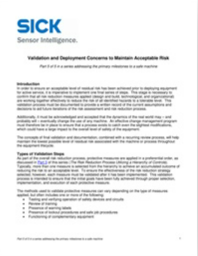Validation and Deployment Concerns to Maintain Acceptable Risk
In order to ensure an acceptable level of residual risk has been achieved prior to deploying equipment for active service, it is imperative to implement one final series of steps. This stage is necessary to confirm that all risk reduction measures applied (design and build, technological, and organizational) are working together effectively to reduce the risk of all identified hazards to a tolerable level. This validation process must be documented to provide a written record of the current assumptions and decisions to aid future iterations of the risk assessment and risk reduction process.
Download this whitepaper for more information.
Read More
By submitting this form you agree to Sick Sensor Intelligence contacting you with marketing-related emails or by telephone. You may unsubscribe at any time. Sick Sensor Intelligence web sites and communications are subject to their Privacy Notice.
By requesting this resource you agree to our terms of use. All data is protected by our Privacy Notice. If you have any further questions please email dataprotection@techpublishhub.com
Related Categories: Components, Industrial, Power, Protection Devices


More resources from Sick Sensor Intelligence

Selecting Safety Standards for Machine Safeguarding Requirements
“Safety standards” are requirements designed to ensure the safety of people around products, activities, or processes. They may be advisory or ...

Functional Safety for Machine Controls
When implementing technical protective measures (also referred to as “safeguards”) from the hierarchy of controls, as discussed in Part 3 of th...

How to Ensure Packaging Machine Flexibility on Cartoners Advancements in Background Suppression Technology Boost Productivity
An automated cartoning machine may be one of the last major components positioned in a packaging line, but it's hardly the least important contribu...

